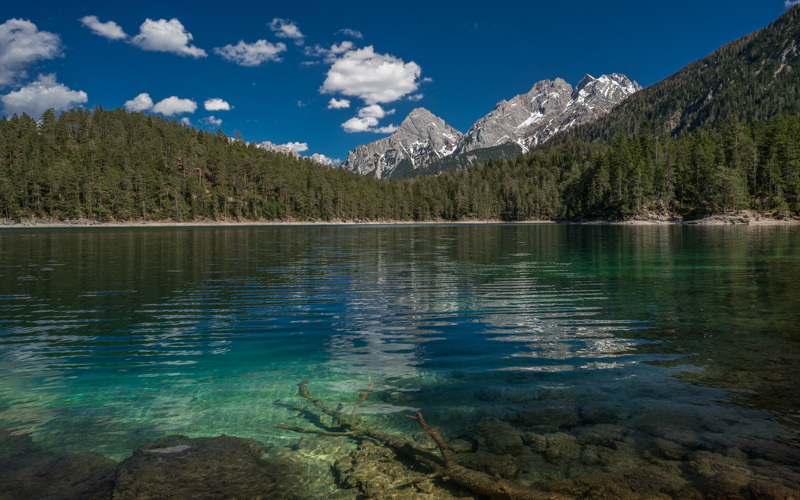
We summarize our experience with all the native E-mount and a few manual legacy lenses in the 20-28mm bracket to give you a compact and independent resource for choosing the right wide-angle lens for your Sony A7/A9/A1 camera. In this summary we also included some adapted lenses we think are worth mentioning. We didn’t include any zoom lenses, you can find those in our general guide to FE lenses as well as the guide to 9-18mm ultra wide angle lenses.
You may also want to check out our guides to 35mm lenses, 50mm lenses and 85-200mm portrait lenses.
Some of these lenses are manual focus only (MF) whereas others feature auto focus (AF). There is also a noticeable amount of lenses listed here that do not feature electronic contacts to communicate with the camera (no Exif).
We have no association with any manufacturer apart from occasionally loaning a lens for a review. Before any short introduction we tell you how long we have used a lens and if we have borrowed it from a manufacturer. But in most cases we have bought the lenses on the market. If you want to support our independent reviews please consider using one of the affiliate links. It doesn’t cost you anything and helps us a lot.
If we have left any question unanswered please leave a comment or contact us on social media and we will do our best to answer it.
Last update: March 2025, Voigtländer 28mm 1.5E Nokton, Viltrox 28mm 4.5 AF added
Contents
- Sigma 20mm 1.4 Art DG DN
- Sigma 20mm 1.4 Art (former DSLR design)
- Sony FE 20mm 1.8 G
- Viltrox 20mm 1.8 PFU RBMH
- Sigma 20mm 2.0 C DG DN
- Tokina Firin 20mm 2.0
- Tamron 20mm 2.8 Di III OSD M1:2
- Viltrox 20mm 2.8 AF FE
- Canon (n)FD 20mm 2.8
- Laowa 20mm 4.0 Zero-D Shift
- Voigtlander 21mm 1.4 Nokton E
- Zeiss Loxia 21mm 2.8
- Voigtlander 21mm 3.5 Color-Skopar E
- Brightin Star 23mm 5.6 Pancake
- Sony FE 24mm 1.4 GM
- Sigma 24mm 1.4 Art DG DN
- Sigma 24mm 1.4 Art (former DSLR design)
- Samyang 24mm 1.8 AF
- Viltrox 24mm 1.8 AF FE
- Sigma C 24mm 2.0 DG DN
- Sony FE 24mm 2.8 G
- Samyang 24mm 2.8 AF
- Tamron 24mm 2.8 Di III OSD M 1:2
- Canon nFD 24mm 2.8
- Sigma C 24mm 3.5 DG DN
- Zeiss Batis 25mm 2.0
- Zeiss Loxia 25mm 2.4
- Laowa 28mm 1.2 Argus
- 7Artisans 28mm 1.4 FE+
- Sigma 28mm 1.4 (former DSLR design)
- Voigtländer 28mm 1.5E Nokton
- Viltrox 28mm 1.8 AF FE
- Sony FE 28mm 2.0
- Zeiss C/Y 28mm 2.0
- Zeiss C/Y 28mm 2.8
- Pentax K 28mm 3.5
- Viltrox 28mm 4.5 AF FE Pancake
- Closing Remarks
- Other Articles
Sigma 20mm 1.4 Art DG DN
- Very good sharpness from f/1.4
- Very good coma correction
- Correction of longitudinal CA could be better
- big and heavy lens yet too high vignetting
- standard 82mm filter thread
- GM-like build (declickable aperture ring, focus hold button, AF/MF switch)
At first sight this does sound like a very good lens, but it shares a significant issue with the Voigtländer 21mm 1.4 E: the vignetting figures are simply too high.
Going by the specifications the main application of a lens like this is astrophotography and for that reason alone you may want to choose it over the “slower” Sony FE 20mm 1.8G, but comparing the actual vignetting figures lenstip derived (which in the past were very similar to mine) you will find out those of this Sigma lens at f/1.4 are 2/3 of a stop higher in the corners than those of the Sony lens at f/1.8, meaning there is hardly any benefit of using the arguably “faster” f/1.4 lens here. If this is really the case I fail to see the point of this lens.
635g | $898 | AF | Exif | Lenstip Review
buy from amazon.com | amazon.de | B&H | ebay.com (affiliate links)
Sigma 20mm 1.4 Art (former DSLR design)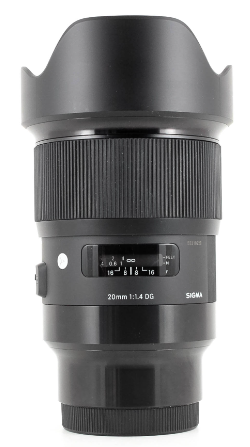
Since it doesn’t perform that well for astro and it is a brick of a lens we find it hard to come up with a use case to begin with and now that the updated and greatly improved true mirrorless design is available there is really no reason to get this one anymore.
1050g | $699 | AF | Exif | Lenstip Review
buy from Amazon.com | Amazon.de | B&H (affiliate links)
Sony FE 20mm 1.8 G
Recommended
- Good from f/1.8, great across the whole frame stopped down to f/5.6
- Good coma correction
- Nice bokeh for a wide angle lens
- Very good CA correction
- Very compact and also lightweight
- GM-like build (declickable aperture ring, focus hold button, AF/MF switch)
A great wide angle choice for a wide range of applications
373g | $898 | AF | Exif | Review
buy from amazon.com | amazon.de | B&H | ebay.com (affiliate links)
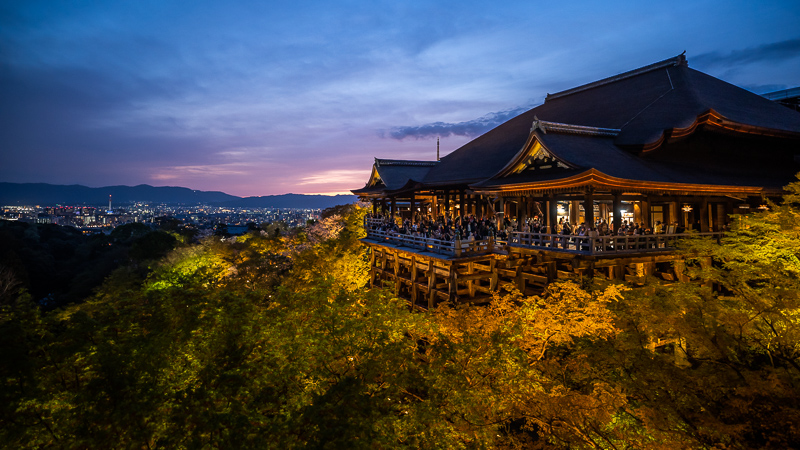
Viltrox 20mm 1.8 PFU RBMH
- Decent sharpness at f/1.8, much better from f/2.8
- High coma, so not a good choice for astrophotography at wider apertures
- Nice bokeh for a wide angle lens
- High vignetting, mediocre flare resistance
Too heavy and not so great optics, therefore hard to recommend
775g | $399 | MF | no Exif | Lenstip Review
buy from Amazon.com | Amazon.de | B&H (affiliate links)
Sigma 20mm 2.0 C DG DN
- Good sharpness
- Good coma correction
- Very high vignetting
- High and wavy distortion
- Good flare resistance
- AF/MF-switch, aperture ring, but no lens button
At the end of the day the only reason to choose this Sigma over the Sony FE 20mm 1.8G is its lower price. When updating this guide the prices were $550 for the Sigma vs $900 for the Sony, so if the massive 4.3 EV vignetting don’t bother you this Sigma can be an interesting alternative.
370g | $549 | AF | Exif | Lenstip Review
buy from amazon.com | amazon.de | B&H | ebay.com | ebay.de (affiliate links)
Tokina Firin 20mm 2.0
- Excellent center and good across the frame sharpness from f/2
- Generally excellent sharpness stopped down but I noticed a midframe drop and some field curvature on my copy.
- A moderate degree of moustache distortion.
- 18-pointed sunstars with pretty average definition from f/11.
- Below average flare resistance.
A sharp lens and a very good choice for astro but for landscape photography the weak flare resistance can be a serious issue. When it was first released there was little competition, but now with the Sigma 20mm 2.0 C DG DN and the Sony FE 20mm 1.8G (if you don’t mind spending a bit more) it became really hard to recommend.
There is now also an AF version of this lens available which is a little lighter but shares the same optics.
490g | $579 (MF) and $699 (AF) | Exif | Review | aperture series | sample images
buy from amazon.com | amazon.de | B&H (affiliate links)
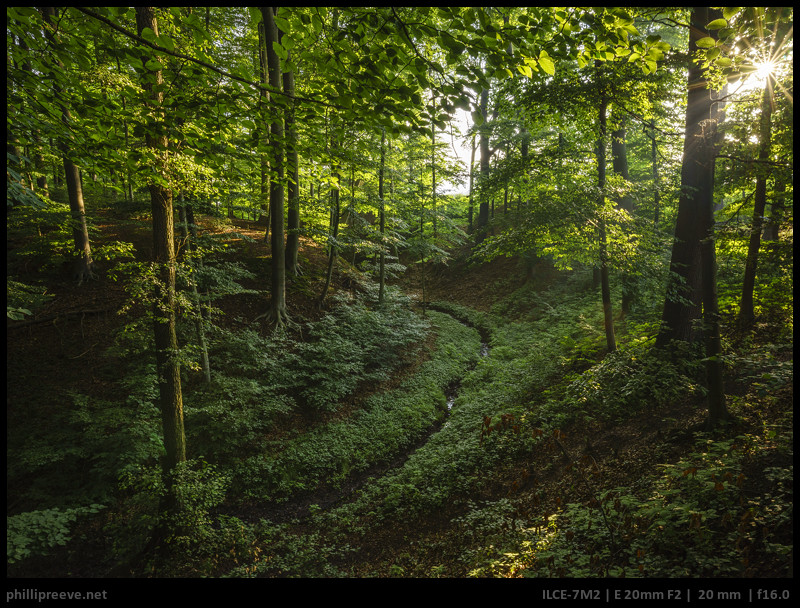
Tamron 20mm 2.8 Di III OSD M1:2
- Very good sharpness at infinity, but distortion is so high that correction will steal away some resolution in the corners
- Very good flare resistance
- Slow autofocus and bad manual focus implementation
- Lightweight but not exactly small
- Maximum magnification of 1:2, but at these distances only good image quality close to the center of the frame
A lens that can give good results but is not very pleasant to use, maybe consider having a closer look at the Tamron 2.8/17-28, especially if you don’t need the 1:2 macro function
221g | $249 | AF | Exif | Cameralabs review
buy from amazon.com | amazon.de | B&H | ebay.com (affiliate links)
Viltrox 20mm 2.8 AF FE
- good sharpness stopped down

- good CA correction
- despite using 7 aperture blades well defined sunstars at f/11 and f/16
- high vignetting
- bad coma correction
- wavy distortion
- small size and low weight
- better build quality than the price suggests
Main competitors are the Samyang 18mm 2.8 AF and the Tamron 20mm 2.8. Considering this Viltrox is by far the cheapest of the bunch I think it compares favourably to the other two, but none of these lenses is perfect, so depending on what you are looking for, you may prefer one or the other.
157g | $158 | AF | Exif | Review | Aperture Series | Sample Images
buy from Viltrox store (use code “PRnet” for 8% discount) | Pergear | amazon.com | amazon.de | B&H | ebay.com for $158 (affiliate links)
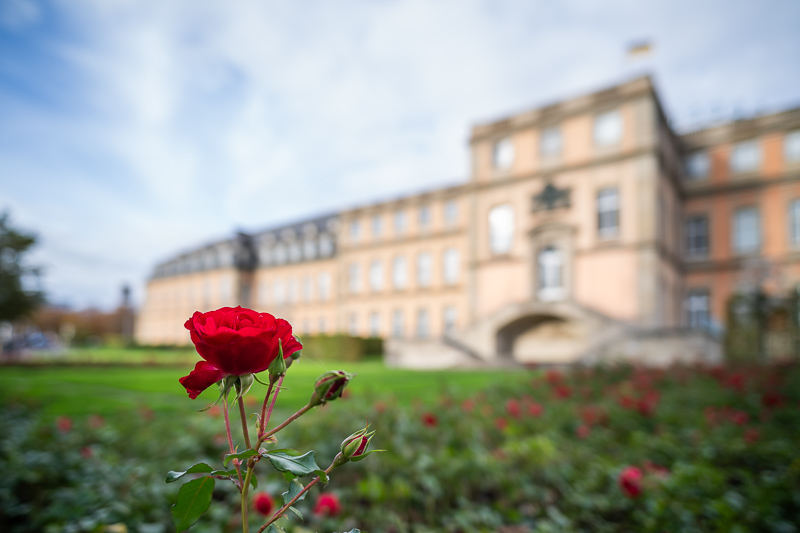
Canon (n)FD 20mm 2.8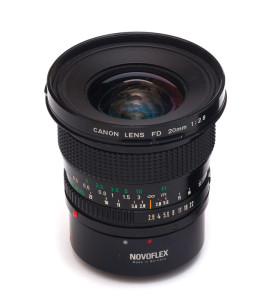
- At f/2.8 the center of the image is sharp but there is strong vignetting, busy bokeh, strong coma and soft corners limit the usefulness of this aperture.
- From f/5.6 it is good across the frame, very good at f/8 and for the very good corner performance you should stop down to f/11
- Some moustache distortion and average to bad flare resistance.
- Medium size and weight.
A capable landscape lens with some limitations. It seems collectors have driven the price up quite a bit over the past years, so you can get the aforementioned native Tamron 20mm 2.8 for roughly the same money or the Viltrox 20mm 2.8 for even less – which is probably the smarter decision for most these days.
305g + adapter | $240 | MF | no Exif | Review | Aperture Series | Sample Images
buy from ebay.com | Sony E-mount adapters (affiliate links)
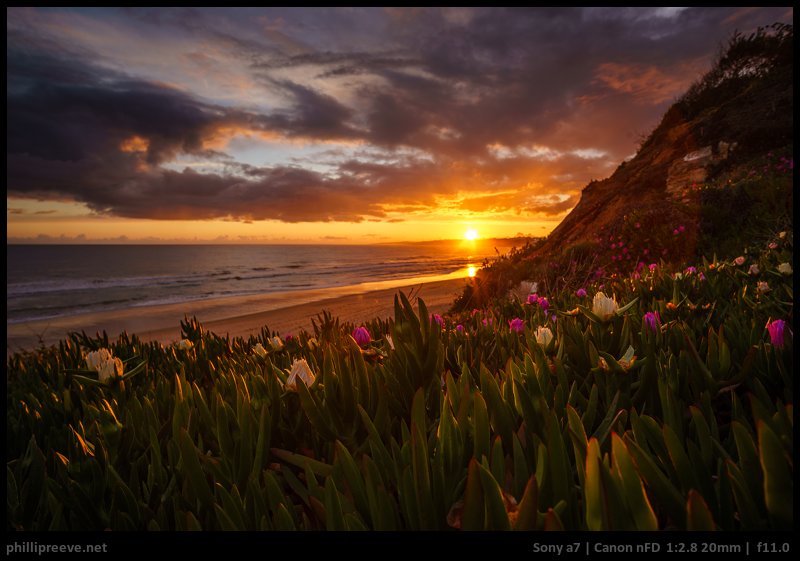
Laowa 20mm 4.0 Zero-D Shift
- in terms of sharpness a bit better than Laowa 15mm 4.5 Shift and Canon TS-E 17mm 4.0L
- very little distortion, good correction of CA, okay flare resistance
- nice mechanics, more easy to operate than Canon’s Shift lenses but no electronic contacts for Exif data
- allows use of standard 82mm filters, the widest shift lens that can do this
If you are looking for a 20mm Shift lens this is the only choice but also a decent one, a bargain for Nikon users compared to the PC-E 19mm 4.0
745g | $1099 | MF | no Exif | full Review | aperture series
buy from manufacturer’s homepage | amazon.com | ebay.com | B&H (affiliate link)
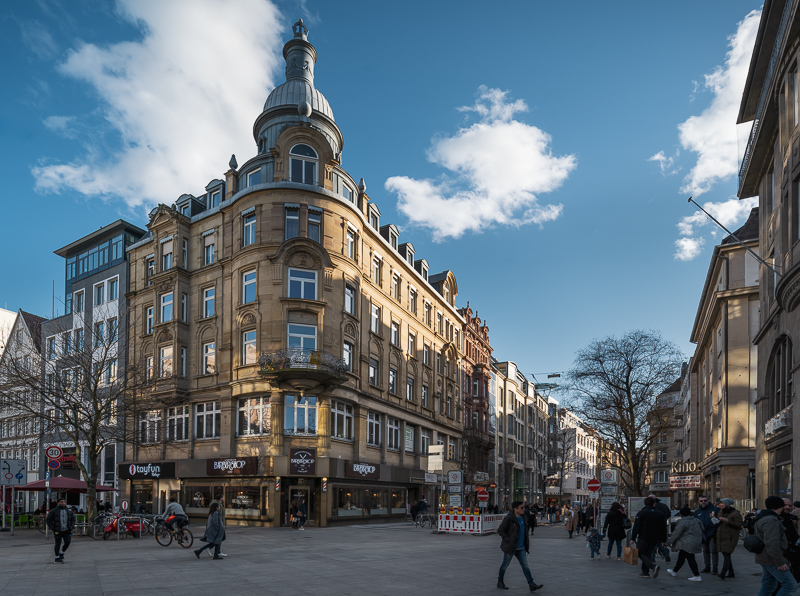
Voigtlander 21mm 1.4 Nokton E
- very good sharpness and contrast but noticeable midzone dip thanks to field curvature
- good flare resistance
- nice distinct sunstars
- very high vignetting
- nice build quality
Thanks to the record breaking high vignetting figures we have similar issues with it as with the Sigma 1.4/24 Art DG DN, so also here the Sony FE 20mm 1.8 G is probably the smarter choice for most. This lens is the best at combining nice distinct sunstars with an f/1.4 maximum aperture though.
Since release this came down a lot in price and I think there is a reason for that.
540g | $899 | MF | Exif | Review
buy from Amazon.com | Amazon.de | B&H | ebay.com (affiliate links)
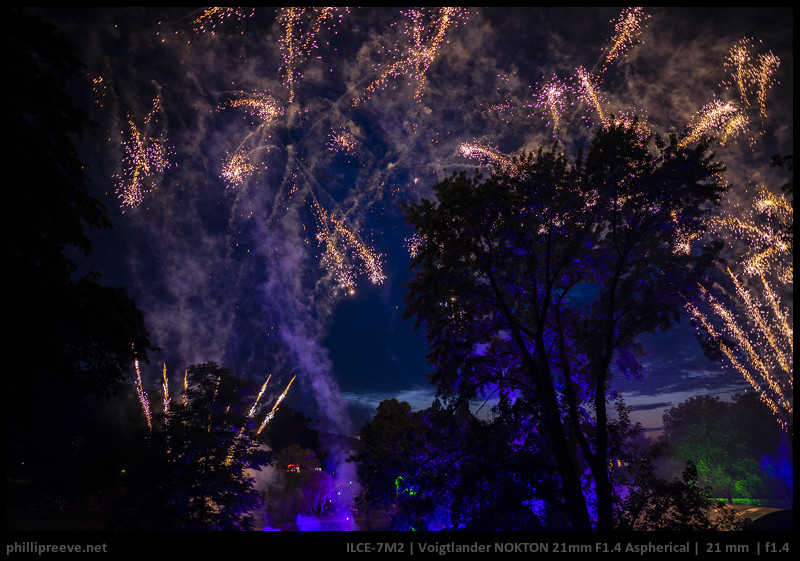
Zeiss Loxia 21mm 2.8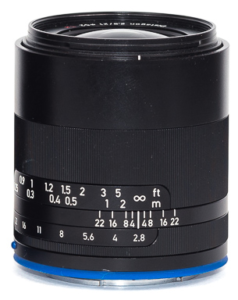
- very good resolution and contrast
- very good flare resistance
- nice distinct sunstars
- high vignetting
- expensive
- nice build quality but consider adding PocketPano Loxia Lens-Grip
If you like manual focus and distinct sunstars this is still a very good choice. If neither is the case be sure to check out the Sony FE 20mm 1.8 G as well.
394g | $1.549 | MF | Exif | Review | Sample Images | Comparison to Zeiss Loxia 25mm 2.4
buy from Amazon.com | Amazon.de | B&H | ebay.com | ebay.de (affiliate links)
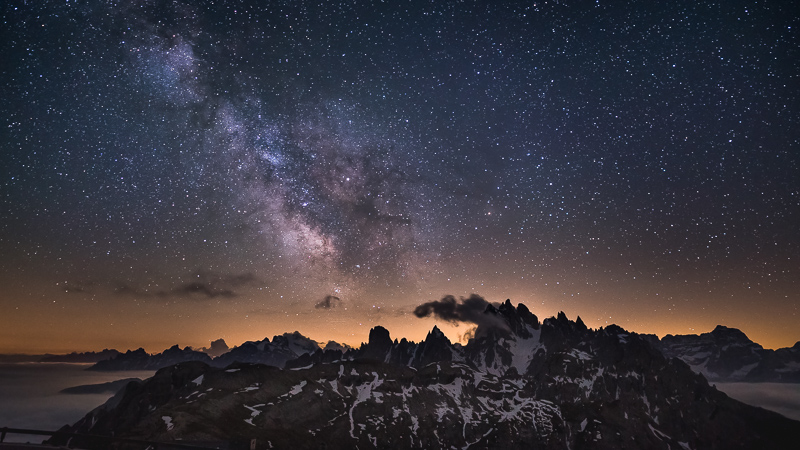
Voigtlander 21mm 3.5 Color-Skopar E
- good sharpness and contrast but a midzone dip at wider apertures
- good flare resistance
- nice distinct sunstars
- very nice build quality
- low weight and small size
Not as good a performer as the Sony FE 20mm 1.8G or the Zeiss Loxia 21mm 2.8, but still very capable, smaller/lighter and more affordable
230g | $599 | MF | Exif | Review
buy from amazon.com | B&H | ebay.com | ebay.de (affiliate links)
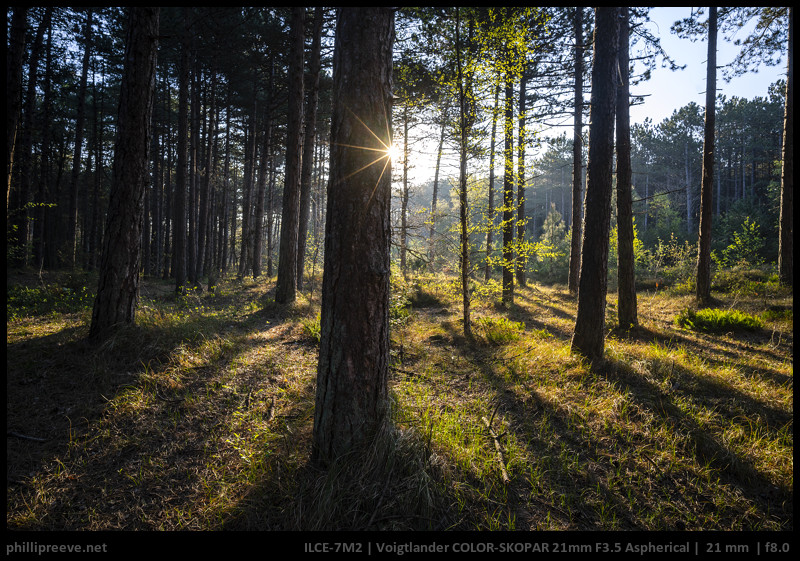
Brightin Star 23mm 5.6 Pancake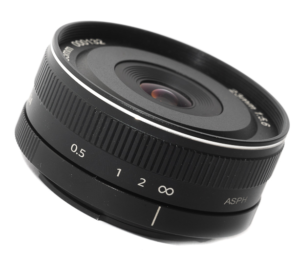
- very compact and lightweight
- bad corner sharpness
- bad flare resistance
- color cast
- fixed aperture
You may be tempted by the low price and very compact size, but most people will not be happy with this lens’ performance.
118g | $98 | MF | no Exif | Review
buy from Amazon.com | ebay.com (affiliate links)
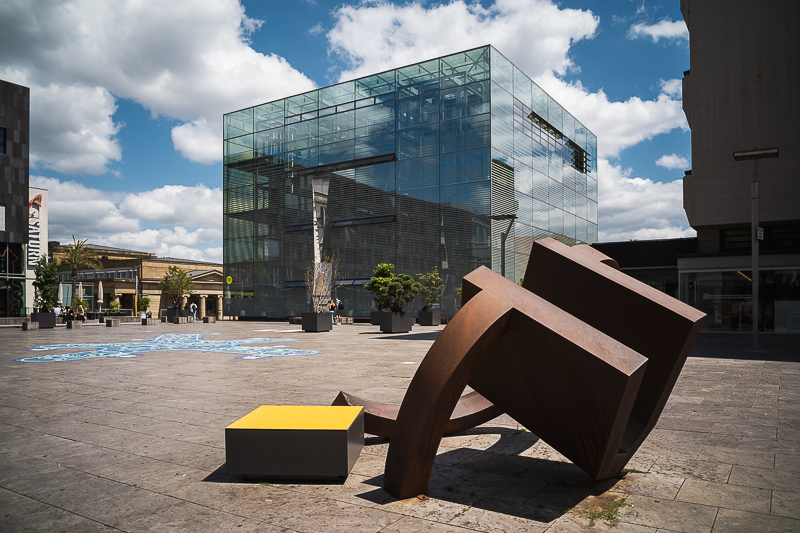
Sony FE 24mm 1.4 GM
Recommended
- very good sharpness and contrast
- very nice bokeh
- good flare resistance
- low coma
- strong vignetting
- really nice build quality (declickable aperture ring, focus hold button, AF/MF switch)
If you need a 24mm 1.4 for environmental portraits or astrophotography this is probably the best money can buy. Surprisingly small and lightweight for what it is.
445g | $1398 | AF | Exif | Review
buy from amazon.com | amazon.de | B&H | ebay.com | ebay.de (affiliate links)
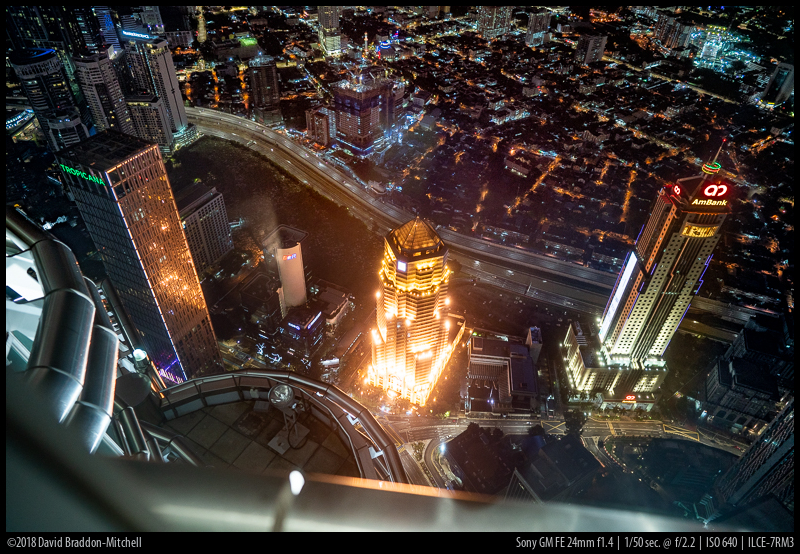
Sigma 24mm 1.4 Art DG DN
- sharpness is good, but it is not as sharp away from the center as you would expect from a complex lens released in 2022
- good flare resistance
- longitudinal CA could be lower
- strong distortion
- GM-like build (declickable aperture ring, focus hold button, AF/MF switch)
A cheaper alternative to the Sony FE 24mm 1.4 GM, before spending 800 bucks on a new Sigma may consider getting a used Sony GM instead though
520g | $799 | AF | Exif | Cameralabs Review
buy from Amazon.com | Amazon.de | B&H | ebay.com | ebay.de (affiliate links)
Sigma 24mm 1.4 Art (former DSLR design)
Now that the updated – and noticeably smaller and lighter and better performing – true mirrorless design is available we cannot really recommend this one anymore.
760g | $849 | AF | Exif | Lenstip Review
buy from Amazon.com | Amazon.de | B&H (affiliate links)
Samyang 24mm 1.8 AF
Recommended
- good image quality
- nice bokeh
- longitudinal CA could be lower
- strong, wavy distortion
- high vignetting
- customizable switch and button
- very low weight and compact
If you don’t care too much about having an aperture ring or nice metal finish but rather want to save some weight and money you may prefer this over the Sigma C 24mm 2.0 DG DN.
230g | $399 | AF | Exif | Review
buy from Amazon.com | Amazon.de | B&H | ebay.com (affiliate links)
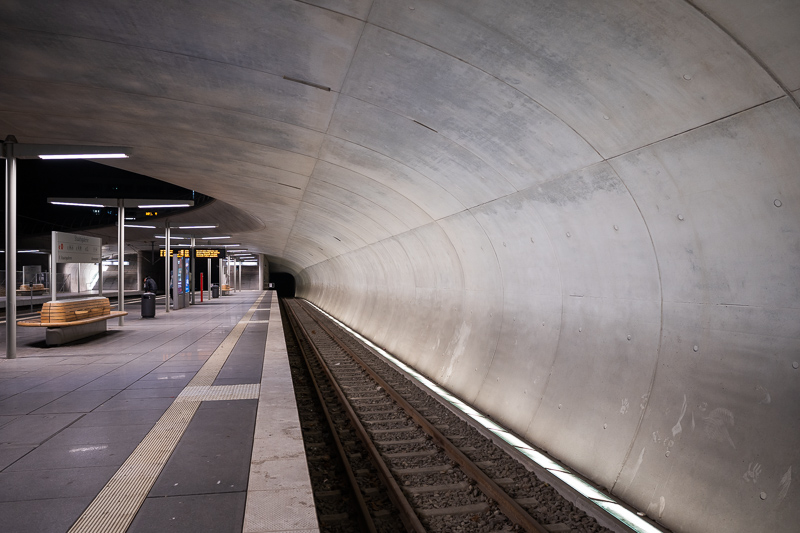
Viltrox 24mm 1.8 AF FE
 good central sharpness and contrast
good central sharpness and contrast- average correction of CA and Coma
- average flare resistance
- nervous bokeh with strong onion rings
- high vignetting at f/1.8
- wavy distortion
In the Sony FE system the Samyang 24mm 1.8 AF looks like a better deal thanks to lower weight, better controls and nicer bokeh. This Viltrox is the only affordable option with AF for Nikon Z though
370g | $379 | AF | Exif | Review | Aperture Series
buy from manufacturer’s store (use the code “MARTINMH” for 8% discount) | B&H | amazon.com | amazon.de (affiliate links)
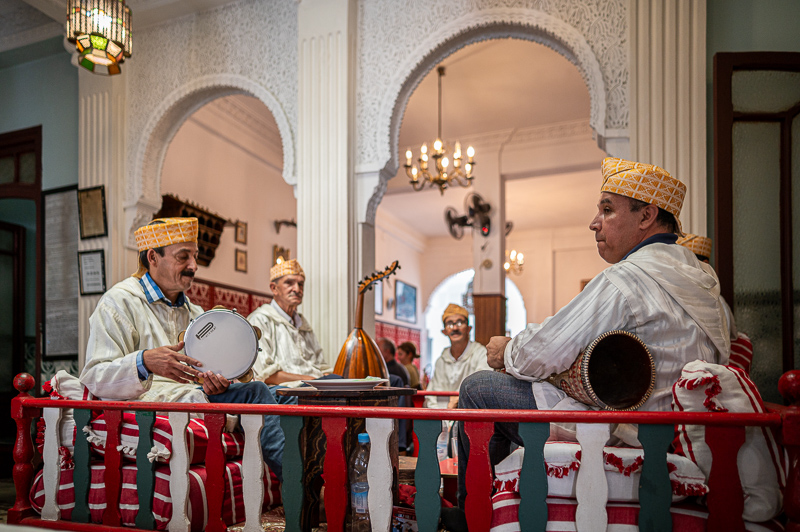
Sigma C 24mm 2.0 DG DN
- high resolution
- good flare resistance
- build quality/handling (AF/MF-switch, aperture ring)
- strong, wavy distortion
- high vignetting
- reasonable size and low weight
A very well balanced lens and therefore a nice, cheaper alternative to the one stop faster Sony FE 24mm 1.4 GM. Also for most a better choice than the one stop slower Sony FE 24mm 2.8 G and especially the overpriced Zeiss Batis 25mm 2.0.
360g | $639 | AF | Exif | Lenstip Review
buy from Amazon.com | Amazon.de | B&H | ebay.com (affiliate links)
Sony FE 24mm 2.8 G
- high resolution
- good flare resistance
- build quality/handling (AF/MF-switch, aperture ring)
- very high distortion in raw
- high vignetting
- small size and low weight
- rather expensive
A solid small lens with shortcomings that won’t bother most users in everyday shooting.
162g | $598 | AF | Exif | Lenstip Review
buy from Amazon.com | Amazon.de | B&H | ebay.com (affiliate links)
Samyang 24mm 2.8 AF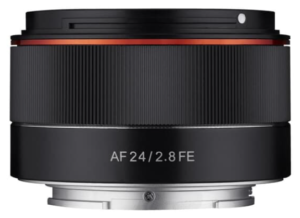
- very small size and low weight
- bad flare resistance
- very high vignetting
- affordable
This affordable lens comes with a number of compromises to achieve its small size. If small size is very important to you it can still be a useful addition. As a general purpose lens we would prefer one of the other options in this focal length range.
93g | $199 | AF | Exif | Review
buy from Amazon.com | Amazon.de | B&H | ebay.com (affiliate links)
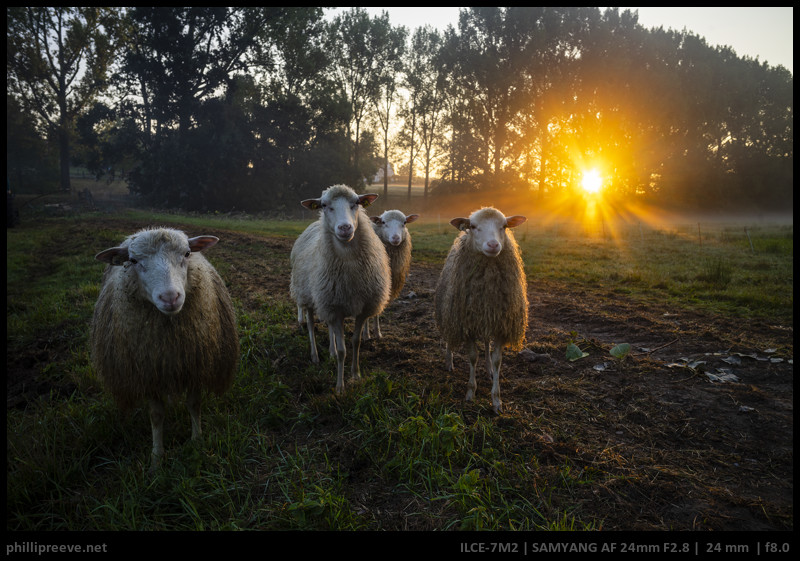
Tamron 24mm 2.8 Di III OSD M 1:2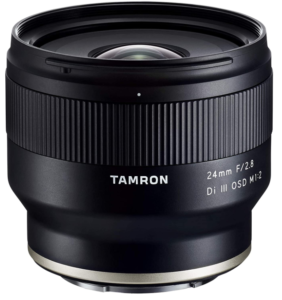
- good infinity sharpness
- good flare resistance
- very high distortion
- slow autofocus
- very bad manual focus experience
- maximum magnification of 1:2
- lightweight but not overly compact
The Tamron is merely an easy recommendation if you want a wide angle macro lens. Beyond that application price is the only argument to get this lens though. Even if you shoot mostly nature where the distortion isn’t usually an issue you will have to live with the focus issues. Have a look at some of the other lenses or a more flexible zoom like Tamron’s own 2.8/17-28 first before making your buying decision here.
215g | $199 | AF | Exif | Review
buy from amazon.com | amazon.de | B&H | ebay.com (affiliate links)
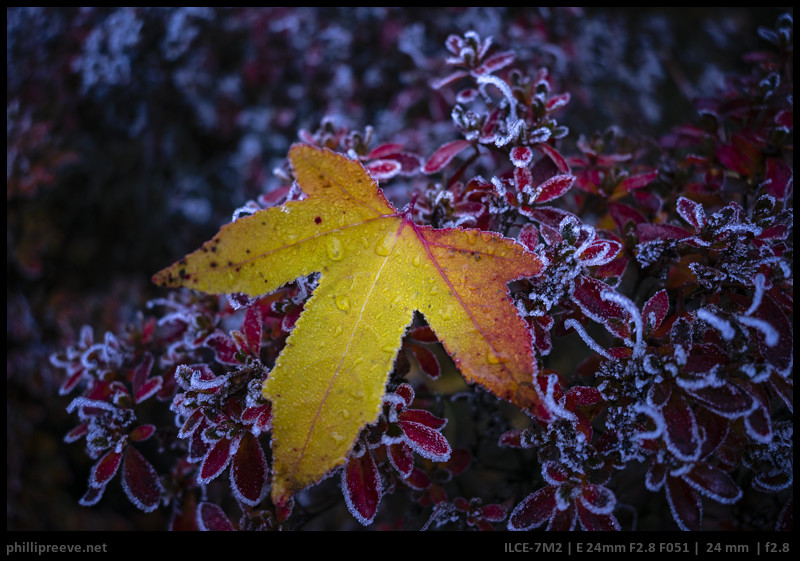
Canon nFD 24mm 2.8
 Noticeable vignetting, busy bokeh, some coma and soft corners at f/2.8
Noticeable vignetting, busy bokeh, some coma and soft corners at f/2.8- good performance across the frame at f/8 and f/11. Only the moustache distortion and average flare resistance can be an issue.
- Quite small and light.
A capable and very affordable landscape lens with some limitations.
240g + adapter | $65 | MF | no Exif | Review | aperture series | sample images
buy from ebay.com | Sony E-mount adapters (affiliate links)
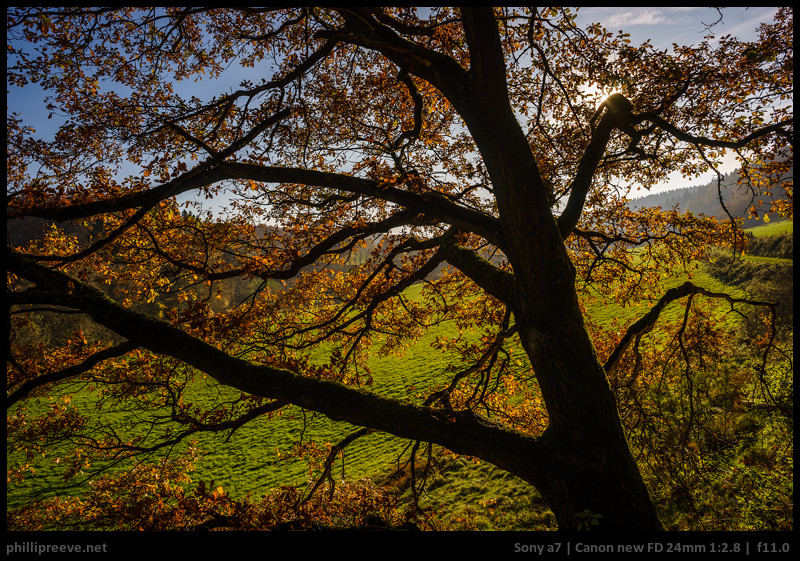
Sigma C 24mm 3.5 DG DN
- high resolution
- good flare resistance
- nice build quality/handling (AF/MF-switch, aperture ring)
- high vignetting
- lightweight and compact
A good lens, but then it is slower than many zoom lenses offering a 24mm setting and for $90 more you get the Sigma C 24mm 2.0 DG DN which is 1 1/2 stops faster while only being 130g heavier. If you are on a budget or you are looking for the smallest/lightest 24mm lens with AF there is still the Sony FE 24mm 2.8 G, Samyang 24mm 2.8 AF and the Tamron 24mm 2.8, so in the end this Sigma doesn’t look super appealing to us.
230g | $499 | AF | Exif | Lenstip Review
buy from Amazon.com | Amazon.de | B&H | ebay.com (affiliate links)
Zeiss Batis 25mm 2.0
- good resolution
- high contrast from f/2.8
- generally appealing bokeh but can be busy at some distances
- some issues with longitudinal CA
- lightweight but unnecessarily big
After the release of the Sigma C 24mm 2.0 DG DN and the Sony FE 24mm 1.4 GM the Batis 25mm 2.0 has become really hard to recommend, especially when buying new from a dealer at full retail price.
335g | $1349 | AF | Exif | Review
buy from B&H | Amazon.com | Amazon.de | ebay.com (affiliate links)
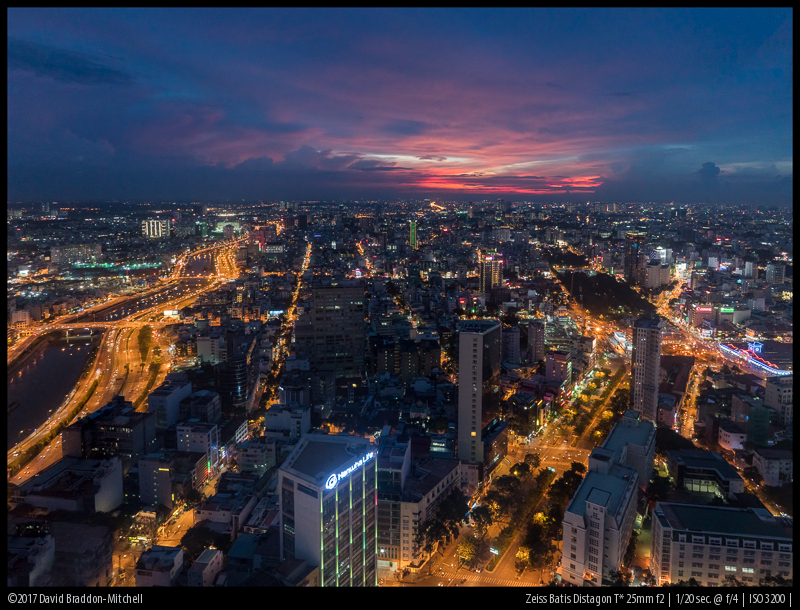
Zeiss Loxia 25mm 2.4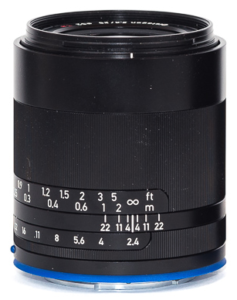
- great resolution and contrast
- very good flare resistance
- nice bokeh for a wide angle lens
- nice distinct sunstars
- longitudinal CA could be a bit lower
- high vignetting
- expensive
- nice build quality but consider adding PocketPano Loxia Lens-Grip
A very high performing wide angle lens. Recommended to demanding landscape photographers who prefer 25mm over 21mm and manual focus as well as nice sunstars over the f/1.4 speed advantage of the Sony FE 24mm 1.4 GM.
393g | $1349 | MF | Exif | Review | Comparison to Zeiss Loxia 21mm 2.8
buy from Amazon.de | Amazon.com | B&H | ebay.com (affiliate links)
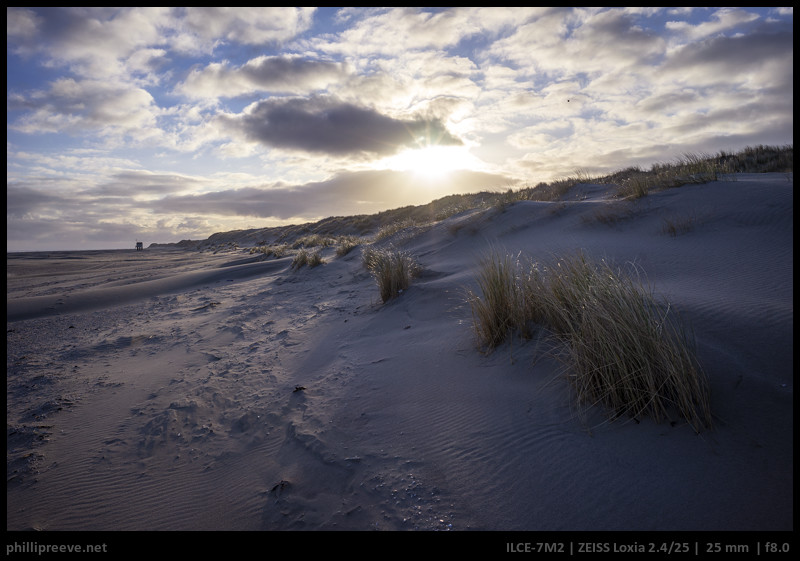
Laowa 28mm 1.2 Argus
- unique combination of maximum aperture and focal length

- nice bokeh (mostly)
- good sharpness and very high contrast from f/1.2
- build quality and size
- decent CA and Coma correction
World’s fastest 28mm lens and thanks to very high contrast already at f/1.2 a great choice for environmental portraiture. Generally good correction of most optical aberrations for an f/1.2 lens.
550g | $599 | MF | no Exif | Review | Sample images
buy from manufacturer’s shop | B&H (affiliate links)

7Artisans 28mm 1.4 FE+
- nice bokeh
- good sharpness
- good CA correction
- nice build quality but long minimum focus distance of 0.7 m Recommendation: use it with a helicoid adapter
- compact but a bit heavy
A great fast 28mm lens equally useful for shallow depth of field photography, environmentral portraiture and stopped down landscape shooting
490g + adapter | $436 | MF | no Exif* | Review | Sample images
*can be combined with TTArtisan 6-bit adapter to get Exif
buy from manufacturer’s shop | B&H | amazon.com | amazon.de | ebay.com | ebay.de (affiliate links)
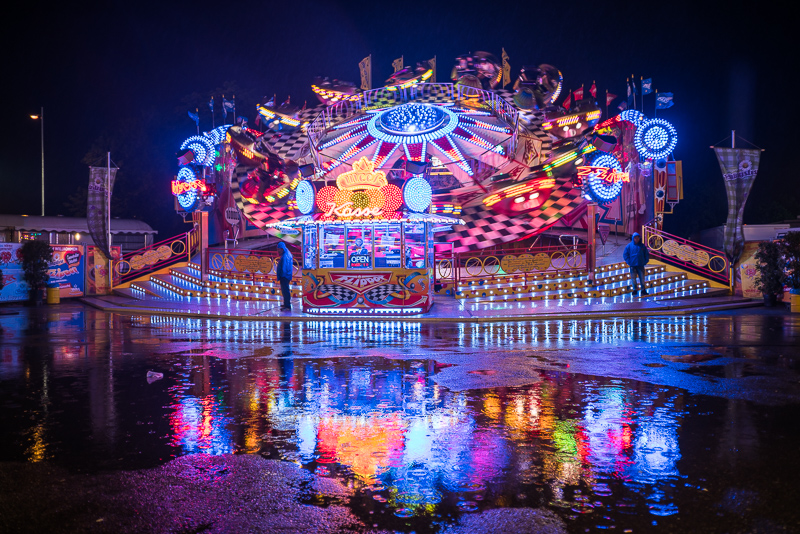
Sigma 28mm 1.4 (former DSLR design)
Recommended (when looking for a 28mm 1.4 lens with AF)
- great sharpness and resolution
- good coma and CA correction
- flare resistance should be better
- very big and heavy
The best (and only) 28mm 1.4 lens with autofocus in the E-mount world.
925g | $799 | AF | Exif | Review
buy from Amazon.com | Amazon.de | B&H | ebay.com (affiliate links)
Voigtländer 28mm 1.5E Nokton
- good sharpness in most cases
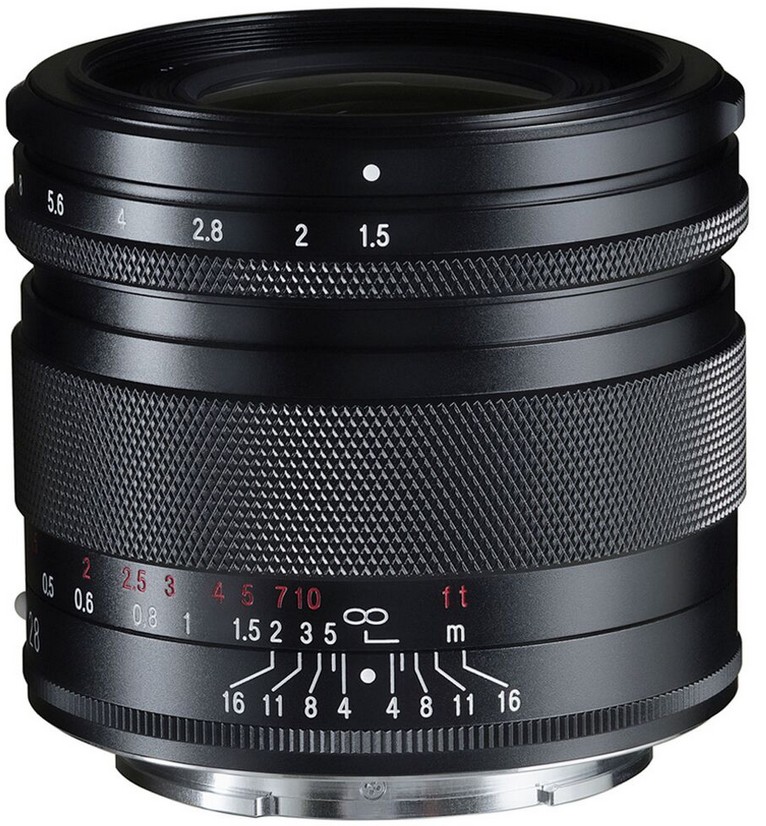
- nice bokeh at close to mid distances
- appealing sunstars
- very good flare resistance
- small size and low weight
- high vignetting also stopped down
If you are looking for a fast 28mm lens and you are fine with manual focus only this is an appealing and very compact option. Advantages over the 7Artisans 28mm 1.4 are Exif data, a better minimum focus distance and appealing sunstars.
320g | $799 | MF | Exif | Review (M-mount version)
buy from B&H | ebay.com | ebay.de (affiliate links)
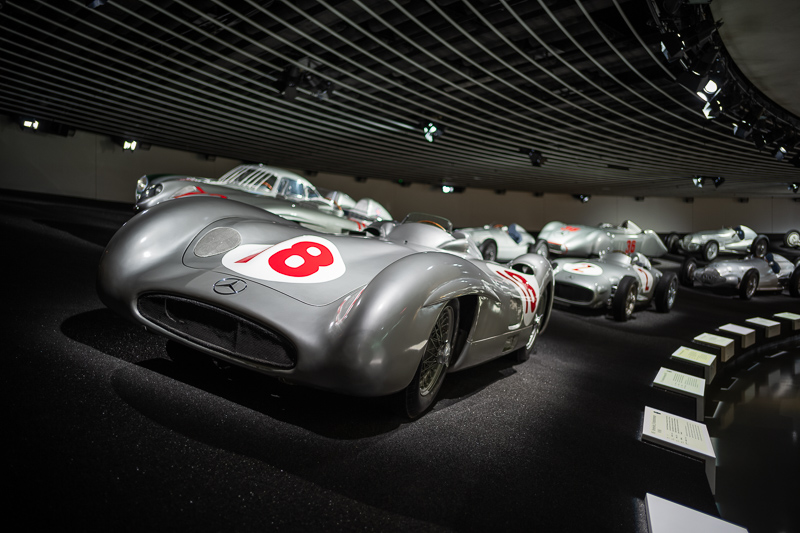
Viltrox 28mm 1.8 AF FE
- very nice bokeh

- sharpness (except for the corners at wider apertures)
- good coma correction from f/2.8
- average flare resistance and CA correction
- high vignetting at f/1.8
- wavy distortion
The comparison to the Sony FE 28mm 2.0 is a complicated one. I prefer the bokeh, CA correction and sunstars of the Viltrox, but the flare resistance as well as size and weight of the Sony lens.
366g | $379 | AF | Exif | Review | Aperture Series | Sample Images
buy from manufacturer’s shop (use the code “PRnet” for 8% discount) | B&H | ebay.com (affiliate links)

Sony FE 28mm 2.0
- sharp in the center from f/2.0 with smooth bokeh

- high amount of longitudinal CA can be an issue
- best corner sharpness at f/8.0
- high vignetting
- good flare resistance
- very high distortion that needs to be corrected for architecture subjects
- no buttons or other controls
A small lens with a good albeit not outstanding performance which is quite versatile because of its f/2.0 maximum aperture.
200g | $448 | AF | Exif | full review | aperture series | sample images
buy from amazon.com | B&H photo (affiliate links)
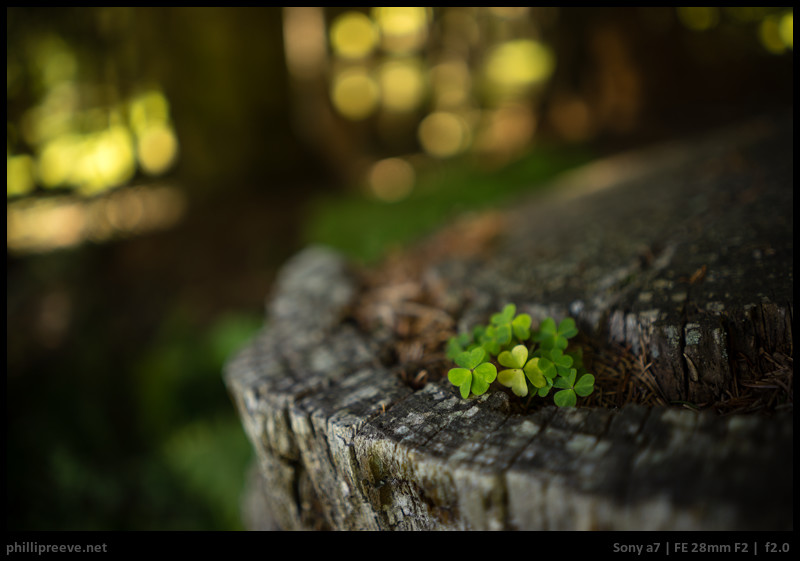
Zeiss C/Y 28mm 2.0
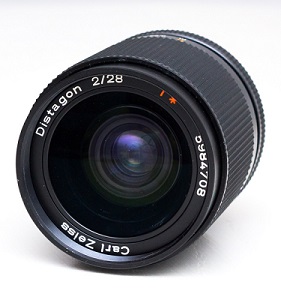 good center image quality at f/2.0 with significant vignetting
good center image quality at f/2.0 with significant vignetting- good image quality at f/8 with decent corners
- good flare resistance, average vignetting and moderate distortion.
- build quality is great, but it is long and heavy.
- good close up performance with nice bokeh
- bad coma correction and high CA
- strong field curvature (bent inwards), that results in great plasticity and an even lower depth of field towards the corners than you would expect in an f/2.0 lens. The field curvature can be tricky for landscape shots, careful focusing is important.
An unconventional lens with interesting bokeh that has become an expensive collector’s item – like any Zeiss lens with a nickname
530g + adapter | MF | no Exif | $1000 | Review
buy from ebay.com | Sony E-mount adapters (affiliate links)
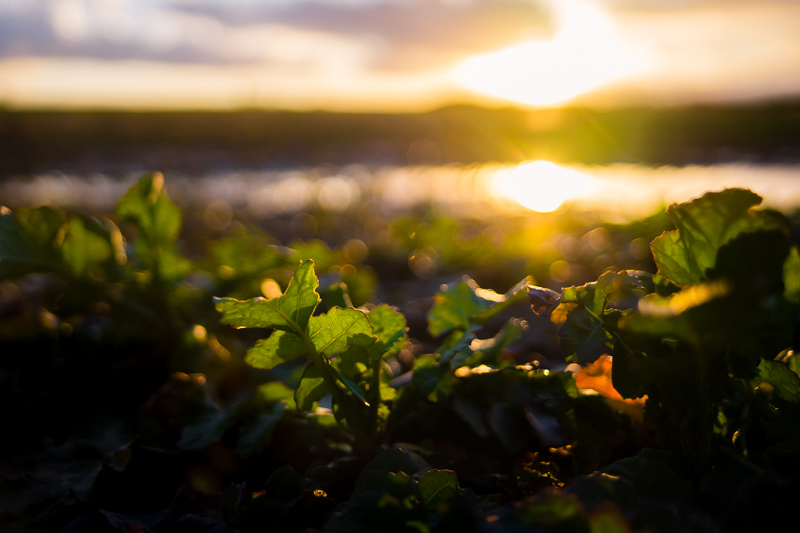
Zeiss C/Y 28mm 2.8
- Good image quality across most of the frame at f/2.8 with
 significant vignetting and busy bokeh.
significant vignetting and busy bokeh. - Excellent image quality at f/8 with the exception of the extreme corners
- Good flare resistance, average vignetting and moderate distortion.
- Build quality is great, size and weight average. The price performance ratio is decent.
An enjoyable lens which’s strength is landscape photography. Only the soft extreme corners are a bit annoying.
280 g + adapter | MF | no Exif | $250 | review | sample images
buy from ebay.com | Sony E-mount adapters (affiliate links)
Pentax K 28mm 3.5
- good sharpness in the center from f/3.5, good across frame at
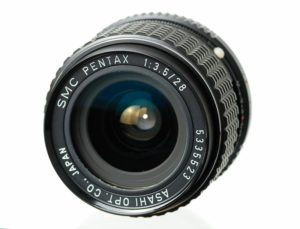 f/8.0
f/8.0 - very good flare resistance for a lens this age, still good today
- average distortion and vignetting
- nice build quality, average size and weight
- affordable but rare
Used to be Phillip’s favorite landscape lens until it had been replaced with the Zeiss Loxia 25mm 2.4.
261g + adapter | $100 | MF | no Exif | review | aperture series | sample images
buy from ebay.com | Sony E-mount adapters (affiliate links)
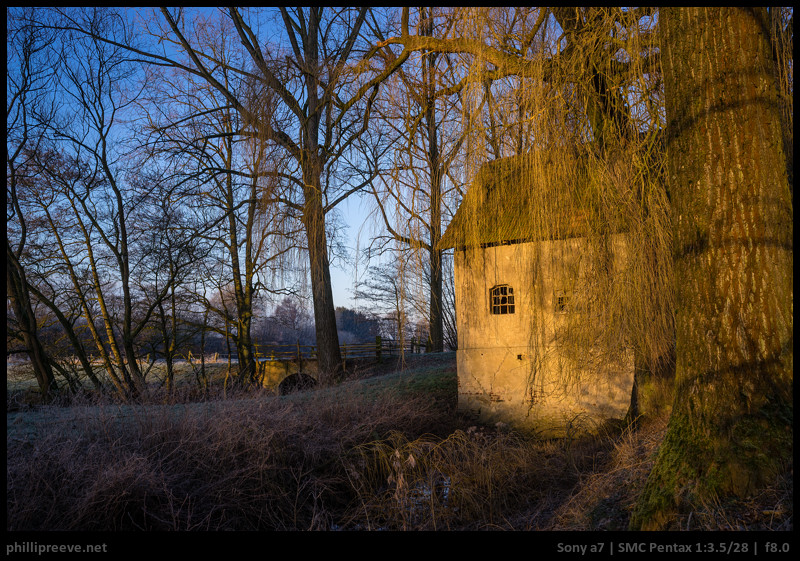
Viltrox 28mm 4.5 AF FE Pancake
- tiniest fullframe autofocus lens
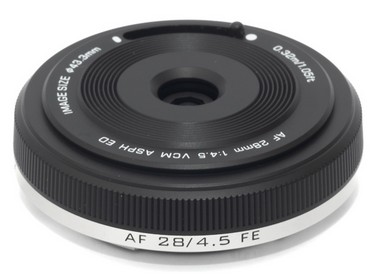
- good CA correction
- low distortion
- decent sharpness, vignetting and flare resistance
- fixed aperture
- no manual focus
- no filter thread
- slight color cast in the corners
A true pancake that even comes with autofocus. It cannot be stopped down, cannot be focused manually and doesn’t feature a filter thread An intriguing, quirky lens that can be bought at a fair price.
58g | $99 | AF | Exif | Review | Aperture Series | Sample Images
buy from manufacturer’s shop (use the code “PRnet” for 8% discount) | B&H | ebay.com (affiliate links)
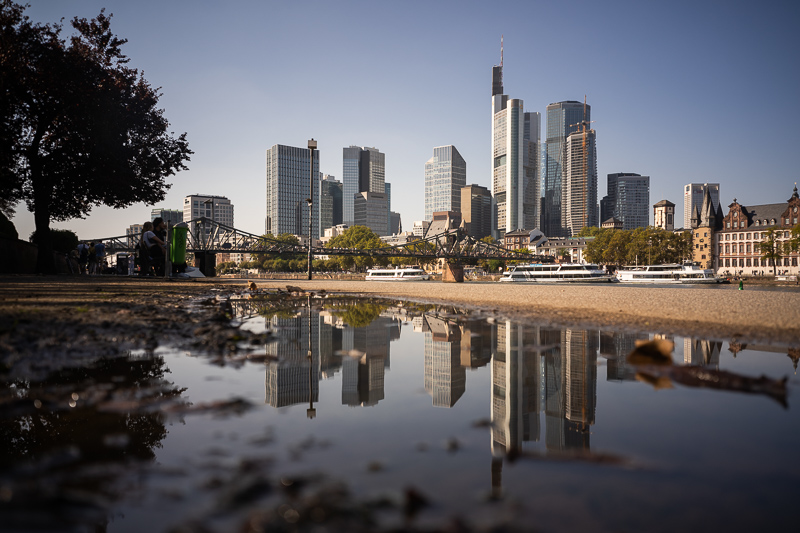
Closing Remarks
Articles like this require many hours of work. If you found it helpful, you can support us by:
- Using one of our affiliate links if you buy a lens (or anything else).
- If you own an interesting and/or exotic lens and you would be willing to part with it for a few weeks for us to write a review just leave a note.
- It also helps a lot if you share this article on social media and with your friends.
Thanks! Bastian, Martin, David, Jannik, Juriaan and Phillip
Other Articles
- Our lens reviews
- Lens aberrations explained
- Tripods for Mirrorless Cameras
- Manual lenses on the Sony A7 – A beginners guide
Support Us
Did you find this article useful or just liked reading it? Treat us to a coffee!
![]()
![]()
![]() via Paypal
via Paypal
This site contains affiliate links. If you make a purchase using any of the links marked as affiliate links, I may receive a small commission at no additional cost to you. This helps support the creation of future content.
The Team
Latest posts by The Team (see all)
- November / Black Friday Deals 2025 - November 19, 2025
- Sony FE Lenses: The honest Guide for the A7/A9/A1 Series - March 18, 2025
- Guide to best Sony E-Mount 35mm Lenses for A7/A9/A1 series - March 8, 2025
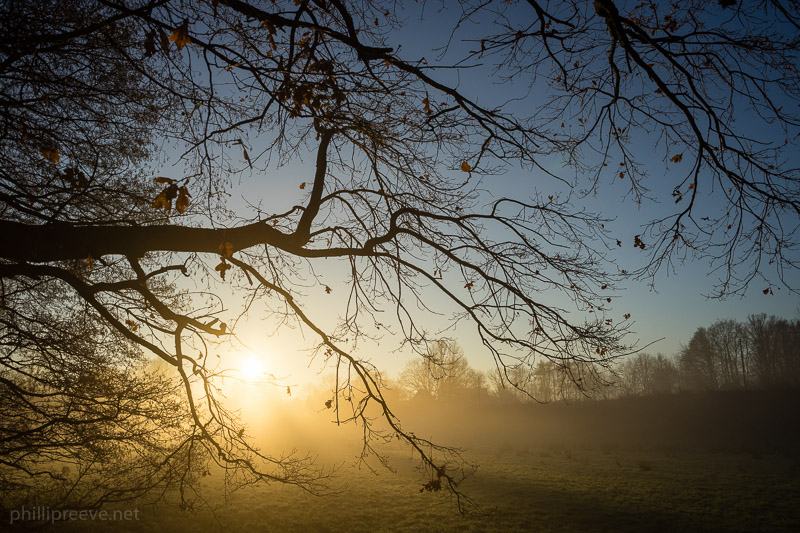
Hi Phillip,
This was a great roundup and very helpful. I’ve been reading your reviews for quite some time now, and I really like your straight forward approach to reviews, and have learned a lot from reading them.
I was curious if you planned to continue to expand on this article and include any of the following lenses.
1. Voigtlander Super Wide-Heliar 15mm f/4.5 Aspherical III
2. Zeiss Batis 18mm f/2.8
3. Rokinon 14mm f/2.8 ED AS IF UMC
4. Zeiss Loxia 35mm f/2 Biogon T*
5. Rokinon 24mm f/1.4 ED AS IF UMC
6. Voigtlander Heliar-Hyper Wide 10mm f/5.6 Aspherical
7. Rokinon 35mm f/1.4 AS UMC
8. Sigma 35mm f/1.4 DG HSM Art Lens for Sigma SA and MC-11 Mount Converter/Lens Adapter for Sony E Kit
9. Venus Optics Laowa 15mm f/4 Macro
We will publish a super-wideangle lenses article rather soon, it will cover lenses 1-3 and 6 in your list and a few others. 4. is already in this list and the others are not too likely to appear soon since we are always a bit sceptic of Samyang lenses because of their bad quality control.
Sweet! Thanks PR.
Thanks. I know the Samyangs get a bad rap for quality control, but was still hoping you’d include them – maybe some kind of discloser about quality with the review would help.
FYI, my experience: Three Samyang/Rokinons (one “new-other” EOS-M 50mm f.1.2, unmounted… two 12mm f.2.0’s used for under 50 shots each, in all probability) — two arrived with defectively tight and binding focus rings (effectively unusable); one O.K.
I work allot with Samyang lenses (35/1.4 14/2.8 85/1.4 135/1.8)
and I think it is a shame you don’t test them with the poor excuse ” Although Samyang offers a few full frame lenses with E-mount, these are just really big SLR lenses with a permanent adapter and we don’t count those as native E-mount lenses. Samyang also has some real issues with quality control and longevity of their lenses.” but you will test Canon lenses like “Canon 20/2.8 305g + adapter | $160 |” or “Pentax K 3.5/28” “Voigtlander 1.7/35 VM” and other lenses who are “these are just really big SLR lenses “.
and we can talk about quality control of each company starting from Zeiss and Sony lenses.
if you don’t like Samyang that’s FINE! but do not make poor excuses and just say that.
for now you just ignore Samyang but it is coming from you not because something that Samyang do or did.
I’m not getting anything from Samyang I’m just a photographer like you that work and enjoy Samyang lenses just as much as I enjoy this site. but I can’t take the site seriously.
1. If you want to take part in the discussion here you will need to show some respect in the future or we will block your comments. Criticism ist great, but please make it about the subject and not the person.
2. The Voigtlander 1.7/35 isn’t an SLR lens and the other two lenses are much smaller than any of the SLR-Samyang lenses.
3. Sony has issues with centering quality, that’s true and we have written about that in the past. But their issues aren’t as significant as those you have with Samyang lenses and Bastian with his 4 out of 5 bad 2.8/14 lenses is just one example for that.
4. We don’t ignore Samyang, we have a review of the 2/135 (not 1.8 as you write), I have written about the 1.4/85 in the past and we have an upcoming review of the FE 1.4/50 and the 2.8/14 will be covered in our super-wideangle lens article. This page is mostly a hobby-project and we don’t run any adverts on this page so we stick to the lenses which we find interesting and we think neither the 1.4/24 nor the 1.4/35 is interesting to us for the reasons we have already given. That’s just us though and if you like the lenses and can use them for your photography great.
We blocked another message by this user and we will block all further messages by him because we don’t see any sense in wasting our time arguing with someone who is unable or unwilling to discuss things in a civil manner.
Awesome post! Many thanks! How come no minoltas and no samyangs? I heard the 35mm is quite good (I have the 14mm).
The Minolta 2.8/35 and 1.8/35 could have been in the list, the 2.8 is a very good and affordable performer and the 1.8 a nice character lens. Maybe I will add them later but we had to start somewhere and this article is already quite long. Another lens which could have been included is the MD 2/28 but I haven’t gotten my hands on one yet but I am pretty sure that it is a very good performer.
The Samyangs are very large and have a lot of variance so we are a bit vary of them but the 14mm will be included in the super-wideangle guide
Thank you for the reply 🙂
Good luck finding the MD28/2 (I’ve been trying for a while…).
A head-to-head shootout of the MD35/2.8 and the nFD35/2.8 would be interesting too.
If you want a Minolta MD35/1.8 (“MDII”, the small 2nd version) for a comparison, just say the word.
I second that shootout request, Jan. I have a clean example of the Minolta with a one previous owner history. Unlike myself, that fellow did not care for the 35mm field of view on film, so he barely used it. A Canon FDn 35mm f.2.8 came loaded with fungus, and I will not even have such lenses inside the main portion of the house.
I can’t fairly test the Minolta at present, as I no longer have access, for now, to a full frame Sony body: just an A5000 and a Canon M3 in APS-C in anticipation of a Pentax K-1 purchase a bit down the road. Image examples at the artaphot.ch website in comparison with some from Sony’s FE 35mm f.2.8 prompted my interest.
I don’t actually use 35mm much, I prefer 28mm and the FE28/2 is such an obvious choice (I already have a Pentax K28/3.5).
I’m more interested in th 35/2.8s because I have a Minolta MD 35/1.8 (the small 2nd version with 49mm filter thread) that doesn’t get enough use to justify keeping it (it sells at quite hefty prices at the moment…) but I still want to have the focal length covered. The MD35/1.8’s aperture ring jumps from f/1.8 right to f/2.8 (why do almost all Minolta lenses have this one big step before the typical 1/2 stops start???) and the MD35/2.8 is probably going to best the 1.8 from f/2.8 onwards.
I just (a few minutes ago) picked up a MD35/2.8 on ebay (39€ + shipping, from a commercial seller), I’ll do a quick shootout with the 35/1.8 (I’ll probably post it on forum.mflenses.com) but I don’t have much doubt that the 1.8 will go on sale…
The nFD35/2.8 appears to be the best candidate to equal or best the MD35/1.8 so I’ll still try to find one, if only to check.
its great if u have time to test some canon TSE lenses like TSE17/F4 with A7RII – which one the best adapter
thanks 4 awesome post
I might be interested doing a comparison between the TS-E 17mm and the Laowa 12mm 2.8 coupled with their shift adapter. We will hopefully see that happen in the future 🙂
Bastian
I hope so, too, Bastian. That test would be very informative, I think.
Thank you for the comparison! Why haven’t you include the Nikon 20/1.8G in this list? I remember Bastian has used one and it seems very handy in brightness, quality and size.
We will include this in the upcoming 10mm to 20mm lenses article and will also move the Canon 20mm 2.8 there.
Bastian
Thank you!
Very interesting post. I own a Canon FD 20 f2.8 SSC and a Canon FD 17 f4, recently acquired, and I must say I’m really impressed with the performances of the 17, really sharp and almost vignetting free. It works like a charm on the alpha and I find it very interesting for landscapes photography. Thanks a lot for your very useful site and articles.
Giovanni
No Tamron 15-30 F2.8 in this test ? Love this lens on my A7RII
I read many good things about it but it is also huge.
So huge, Phillip, that I have chosen to acquire and test the revised and current version of the Sigma 12-24mm full frame zoom in Nikon mount for adapting to Pentax. That lens can surely cover the bases in ultra-wide at a still fairly moderate girth and weight… and at about 35% of the cost new, here in the States, of Pentax’s iteration of Tamron’s design, if the Sigma is purchased grey market.
I should also note that the true measured focal length of the Tamron at the wide end is closer to 16mm than to 15mm; so the comparison here is really apples vs. oranges, anyway. The extensive image gallery for the Sigma at their website really needs to be seen by anyone even thinking about the truly wide focal lengths on full frame: it definitely tipped me over the edge to considering circa 16mm just not wide enough, particularly with respect to making a picture where, in more conventional terms, there is not much of strong photographic interest.
Unfortunately for me, Sigma dropped the Pentax mount when they introduced the major redesign of this lens. Therefore, some creative, though reversible modifications will be required, along with accepting some practical limitations in use. I will, of course, be following Bastian’s follow up testing of the Laowa 12mm with great interest.
Loxia 21 on Sony is as good as the Leica SEM 21 on M.
Half a stop better and half a price better 😉
Oh, and can be used on a 42MP sensor.
Unlike the nice Loxia 35, the Loxia 21 is a modern state-of-the-art design, and a no-brainer if you can swallow the price.
The Zeiss ZM 35mm f/1.4 distagon is a superb lens that’s always in my bag. Any chance of you reviewing it at some point? It would be interesting to see how it compares to the ZA 35/1.4 distagon. It’s much smaller than the ZA and can be used on any mirrorless system, so one’s not tied down to Sony. I use it on my A7r and A7s.
Seems to be a great lens by anyting I have seen and read so far. A bit too expensive for me though and it has strong competition from the Voigtlander 1.7/35 M.
Furthermore (but the same applies to the CV 1.7/35) I have always mixed feelings when I know that a lens performs significantly better on a different sensor.
Nevertheless, the 1.4/35 ZM is a very exciting lens. I wish, they would have made a Loxia lens out of it. This would have been spectacular.
I have to second that. Was seriously considering the 35mm 1.4 ZM but as I would have to stop down the lens anyway I went for the Loxia 35mm 2.0.
But if there is an E-mount version some day: count me in.
Fred Miranda compared the two and the 1.4 performed quite a bit better in der vorners at f/5.6 and still at f/8
Count me in too.
Hmm you’ve included old lenses that use adaptors, but emitted lenses like the sigma art lenses which act pretty much like as native with the MC-11 adaptor…
The sigmas are much more relevant to most people than a lot of what you’ve included…
So far people have asked why we didn’t include M-mount lenses, Samyang lenses, Sigma lenses, Canon lenses, Minolta lenses and a couple others. I think this shows that people look for differen things in lenses and we will never be able to cover anyones taste. I think as it is we have a pretty solid collection of lenses but you can be assured that it will grow and there is a good chance that we will also include Sigmas, the MC11 is pretty neat and Bastian already owns one.
I have to recommend the EF 17-40 F4 “L”. ~$500, ~500g, fixed length when it zooms, sharp at all focal lengths and apertures. With the Mark II bodies and any AF adapter it focuses at native speeds, and with the MkI bodies AF is usable. I was surprised- it AF’d pretty reliably with my Fotodiox on my ancient NEX-C3!
Only real downsides are it has pretty strong vignetting on the wide end, and compared to these svelte little primes it’s a big honker of a lens. But it’s a workhorse. I use it for a lot…. covering events, indoor architecture, landscapes and general “out on vacation and shooting all of the above” photography. It’s a 1993 design too so I think it retains a good bit of that old school “pop” and charm; but objectively it holds its own with any modern lens. A class above all the slower 3rd party UWA zooms for sure. Something to consider!
Currently my favorite wide angle lens on my sony a7 is an old prime Minolta Rokkor 17mm f4 which I use extensively in cave photography. Incidentally also the rest of my wide-angle collection is also Rokkors, i.e. 20mm, 21mm , 24mm, etc.
https://scontent.xx.fbcdn.net/t31.0-8/13559170_10209083427538439_6795620775374016461_o.jpg
Nice quick summary of a good set of lenses, very helpful reference. No review on the Olympus OM shown in the headline photo?
No review yet 😉
very cool! how about a list of lenses at under $300 at some point?
I already have a list of lenses under $99 and I will do one for lenses under $500 in the furture but it will take some time 🙂
When I acquired the Sigma 12-24mm mentioned above, I also had the chance to jump on a Nikkor ultra-wide zoom from a brick & mortar dealer on eBay at a really budget friendly price, which I think may be a bit of a practical and versatile low cost sleeper in this category for some Sony users. I’m speaking of the Nikkor 18-35mm f.3.5-4.5 AF-D, which was well reviewed, as I take it, by the not always so reliable Ken Rockwell. His overview is thorough.
Plusses include sharp central images at all focal lengths at very useful apertures (according to Ken), a class leading low weight of circa 13 ounces (!), more than decent manual focus handling on my sample, and an honest to goodness old school aperture control ring. The latter means I can adapt the lens to K-mount easily, losing only auto-focus and, as is usual in these cases, the lens will require step down metering. Neither is too big a deal to me, as I won’t really be needing it to handle more than an 18mm to 22mm or so range when I choose to carry it for its low weight and convenience.
One can overlook some limitations given the lens’s extraordinarily friendly carry weight, its straightforward handling and size; and especially, the low cost at which it can today be acquired. My copy is like new in all respects, and with assistance from a 2-day bonus enhancement of the Bonus Bucks ‘rebate’, it came in at under $210 net for me. It’s a pretty nice option to have to complement a 24-35mm prime lens in a lightweight, sensibly priced kit.
The negatives are typical of its era — some resolution issues in the corners and waviness in the distortion characteristic. But I think Ken may be right about its mostly clear, modern rendering… something to consider given the well known limitations of vintage primes in the ultrawide FL range.
I thought wavy distortion was a Nikon feature, not a negative.
Great comparison. One comment to the C/Y Distagon 28mm F2.8. The corner sharpness of my copy is perfect at F8.
It’s a MM Version (Made in Japan) which is made about 1985.
At F5.6 the corners are already very good. (Tested on my Sony A7) These behavior astonished me after reading your preview.
So maybe you could review another copy of that great lense.
Can you share some full resolution pictures with it?
A very useful comparison. I was interested to see your comment on the decentering of your Ultron, Philip – I really enjoyed many aspects of the copy that I had, until I more rigorously tested for decentering, and then it became obvious in almost everything I shot. The Australasian agents gave me a full refund, but couldn’t replace it as they only other copies they had showed the same behavior. A great little lens, if only they could get on top of their quality control, which is so cruelly exposed by the high resolution sensor in the A7RII. I now shoot with a Loxia which is close to the Ultron, but lacks some of its character.
Cosina also had some serious issues with the 4.5/15 III where most lenses did not perform as the better copies. The only way to deal with this is to buy from a source where it is easy to return the lens.
Would be nice to see your impressions of the 28mm Otus + adapter compared to this list. Any chance Zeiss would loan you one to make an addendum?
We will ask them at Photokina, but my hopes are not high 😉
A wide field you’ve opened here ;o)
Here are a few more of my own favourites.
First from Olympus:
OM Z 21/3.5 (later mc version)
OM Z 24/2.8 (later mc version)
I have found both very good, with the caveat of a strong, rather “sharp” vignette, which is hard to remove in Lightroom.
…and from Minolta:
MD 24/2.8
MD 35/2.8
Both the latest version. The weakness I find with the Minoltas especially is flare, but the colours are “delicious”.
Both the above 24mm’s can be seen in my own comparison, along with a few others , over on Fred Miranda Alt. Gear, here: http://www.fredmiranda.com/forum/topic/1342704/0
PS. My Summary on pg 6 #2 of above is probably the best place to start.
I have to say that I get to like the OM lenses more and more. My Canon FD guide is nearly finished and after it is finished I will start to work on a FD guide, will certainly come back to you for that 🙂
Very good review…but I was a bit disappointed. When I decided to buy manual lenses I hesitated between Minolta and Canon so I bought one of each the Canon being a nFD 24 f2.8. Problem with the Canon was the focusing ring with a bit of play and the plasticky feel…
So I saw your ratings of the Minolta lenses (not bad) and went long with the Minolta lenseswhich have much better mech feel (including buying a 24 f 2.8, 35 MD 1.8 and 28f2.0 (even bought the 20mmdespite poor rating because it was so cheap and like new), so I would have expected at least some of them to be included.
Continue the good work.
Hello everyone,
I would like to ask if you are planning on reviewin the original Zeiss 21mm f2.8 Distagon. The reason I am asking is because I am thinking on switching from my beloved D750 to the a7r II and I am between the Batis 18mm and the Loxia 21mm. I’ve read that the Sony + adapters don’t work very well with ultra wides… I was wondering if I should keep the 21 and go for the 18.
Thanks and keep the good work 🙂
I don’t think we will. By all accounts the Loxia 2.8/21 is a better performer, quite a bit smaller and you don’t have to worry about the adapter. Adapter thickness is totally critical with the Distagon.
Hello
My 2 cents worth.
I know this lens is in some ways incompatible, but it works amazingly well, Sony 10-18mm f4 from 12 to 17mm it covers full frame and it very good to the extreme edge which is a big surprise, a bargain too.
I was Surprised my joint favorite lens is not listed, Zeiss 35mm f1.4 ZM with Loxia 35mm F2 with legendary Biogon rendering.
Also the Zeiss 28mm f2.8 ZM fantastic on A7rm2
Another is the Leica 28mm f2.8 R Rom I bought this so that I did not need to lug another Otus around.
The jury is out on the Loxia 21mm, I find it too sharp and does not render as beautifully as the classic 21mm f2.8.
Zeiss 18mm f4 ZM fantastic rendering again but suffers lots of flare soft in the extreme corners. rectified with top quality UV filter.
Zeiss 15mm F2.8 ZF.2 excellent, but to big for landscape use.
Zeiss 25mm f2 Batis number 1 lens awsome replaced my Zeiss 25mm f2 swore I never sell it but Batis better everywhere.
Sony 28mm f2 brilliant value for money.
Great reviews, thanks.
Hello Phillip. Your website is terrific! Very helpful.
I just want to ask for your recommendation in the 24mm or below budget lenses(around $200). If I were to buy just one, which do you think would it be? Thank you.
Canon new fd 2.8/24
Thank you Phillip.
Hello Phillip,
Thank you for your web site, which I enjoy immensely. It is over several months now since I began to visit your web site regularly. It is probably because there are quite a few photos you took that I find appealing to my love of nature/landscape photographs.
Since I took to film photography during my teens before auto focus cameras arrived, I could not forget the beauty and enjoyment of framing objects in manual focus, and I could not resist leaping into the bog of “manual focus lenses and Sony Alpha 7 series cameras” when I came across this web site.
The way you review lenses, which simply sounds a personal hobby as well as a practical guide to many, is also heartwarming to me.
I hope you keep your brilliant work.
Thomas
thanks for the compliment Thomas 🙂
Hi
any experience with the old Sigma 24mm 2.8 Super Wide II macro?
it looks like a bargain at 50-60€…
and thank you for the great work, this site is amazing!
I have briefly used that lens on my Nikon DSLRs and even thought about including it here.
The sharpness is ok to good stopped down, but manual focusing is not a great experience: the focus throw is short, it makes a grinding noise when manually focusing and the rubber is often sticky :-/
Maybe the FD 24mm 2.8 is a better choice.
Optically it is one of the best classic 24mm lenses. I agree with what Bastian said about the mechanics though and would add not that great coatings. The 1:4 MAcro mode is nice though.
Hi Bastian
Thanks for your reply!
In fact I also think that a big part of a lens appeal is related to the build quality/manual focusing experience.
The pb is that you end up buying only zeiss and leica lens :p
Count in Voigtlander, but apart from that: actually (and unfortunately) true…
I have also high hopes for Laowa but their lenses are also far from cheap.
Thanks for your reply Phillip!
I may give it a try, the macro mode is indeed tempting.
Does anybody know when Sony may release a wide angle zeiss quality prime lens in the 20-24mm FL range? It’s a lens that is missing in the Sony line of prime lenses. In A mount they have a Zeiss 24mm f2 though its performance is lackluster. I am expecting a similar one in FE mount and I hope it won’t be disappointing after all the great lenses Sony has offered in the E-mount.
Well since there is the Batis 2/25 and the Loxia 2.8/21 aswell as the Firin 2/20 I wouldn’t expect that another 20mm is high on Sony’s priority list. But that is pure speculation.
Not to forget the 0.75 wide converter for the 28mm 2.0.
Hi,
Great website, I really like your reviews and tests.
Have you ever considered to do some review with modernish Canon lens?
Some of them perform well on Dxo website, and easier and cheaper to by them used than Sony e mount lenses. It would be interesting to see how good they are compare with the sony, zeiss or old manual lens.
Older EF 24 mm f2.8 used is under £150. New 24mm f2.8 is usm is around £350. Dxo score is really good for usm. With Sigma Mc 11 could be a good alternative for Canon 24mm nFd, because now you can hardly find 24 nFd 2.8 under than £150.
Do you have any experiance with modernish affordable Canon lens on sony e mount?
Canon offers some really nice lenses for very fair prices. It is hard to argue with that.
Personally I have tried the EF 2/135 and 4/16-35. Both very good lenses for a very fair price but I didn’t enjoy handling them. And since that is quite important to me I am nit too tempted by lenses like the EF 2.8/24 IS even if it offers very good bang for the buck.
Hello,
I was planning to go FF with Canon 6d but after reading a lot of your blog posts (thank you very much:-)), I really got into Sony a7 and as a really nice one was for sale on DSLR-forum.de I jumped the ship. With it came the 28-70mm which I plan to use for family events with children running around and have the Irix 15mm 2.4 EF with with commlite adapter for astrolandscape.
I ride my bike a lot around dawn (pre-work) so I was thinking about a manual 35mm lens for bike rides. What I would like in the lens is small weight and size – only doable with either Leica or CV M-mount or native, but these are out of my price league 😉 – so the best combo of good flare resistance, bokeh and sunstars is what I aim at. I am torn between Pentax SMC 35mm f2.0 (40mm f2.8 the smallest of the bunch), Oly OM 35mm f2.0(2,8) and C.Zeiss Jena Flektogon 35mm f2.4
Any thoughts on my “suspects” or any other candidate you see fit, would be greatly appreciated.
Cheers, Aleksander
I haven’t used any of your candidates. I am not a fan of Samyang lenses in general but maybe the 2.8/35 AF fits the bill?
If I came from a country (like GB or DE) where returning a faulty item is no hassle I wouldn`t mind having a go at Samyang, but with their low QC reputation I preffer not to take my chances… 😉 if I am going the AF way it will probably be an used Sony FE 28mm f2.0 (I like your review of it + it can also be used for astro) …
Thanks for your feedback…
Aleksander
one more Q, any thoughts on Voigtlander Ultron 40mm f2 asph for ef mount?
cheers,
Aleksander
The NIKKOR Ai-s 2.8/24 works quite well adapted to Sony A7II & A6500. It also uses the 52mm filter, same as my Loxia lenses (2/35 & 2/50), so I don’t need to buy multiple expensive filters such as CPLs.
Than k you for your educational articles–hooah!
Hi Philip,
thanks so much for your & your friend’s amazing blogs!
Did you have a look at the Zuiko OM 1:3.5 / 24mm shift?
I just came back from a trip to provence and I had used this lens for almost 80% of my shots! I bought it after having used a Schneider 35mm PA Curtagon for a while and I must say the Zuiko shift is such a phenomenal lens and fun item to use.
Not only for architecture, but also (if you shift downward) for a dramatic foreground! On a stand I shift upwards, take a left shift, middle, and right shift image, then shift down and take another 3 pics as above.These 6 shots can then be combined into a panorama stich without having moved the camera on the stand at all….
I just upgraded to a Sony Alpha 7r iii from my EOS 5D ii which I loved over so many years and after your notes I just ordered the Voigtlander 1:2/ 65 Apo Macro.
I love manual focus and I am not a big fan of zoom lenses as – besides limited image quality- they limit your ability to explore new “insights”.
Best, and keep going with your great work!
Holger
I haven’t. Mind sharing some higher resolution samples? Should be a pretty useful lens.
Yes I will share a few samples but cannot before next week.
Where / how do I share them?
There is also a review here:
http://www.fredmiranda.com/forum/topic/239317
I use flickr to share large images.
Thanks – I’ll go on Flickr then!
Just checked Flickr. Honestly – too much control over my data, spying of browsing behaviours, anticipated adverts and other spying & spamming I need to agree to in order to use the Flickr account shocking! I think they had to disclose this mess only because of the recengly enforced data protection laws.
Not for me really.
Shall I mail you a dropbox link where you can get some examples? Happy for you to use & post them here.
Hi Phillip,
finally I got away with the personalisation settings in Flickr.
Here is a link if you want to check out some pics taken with the EOS 5D ii, new pics with the adaptation to my new Sony a7r iii will follow.
https://www.flickr.com/photos/hgadm/albums/72157667770964407
A few more pics with the OM Zuiko 3.5 / 24 mm Shift lens – now on the Alpha 7r iii.
Note that I had to compress the pics a bit more in order to be accepted by Flickr. Otherwise non-touched original JPEG photos.
https://www.flickr.com/photos/hgadm/albums/72157691953807310
Note the CA, esp. in the upper part of the church portal pic.
Yet another great article. Very informative. Thanks!
Do you happen to know of a 28 or better a 24mm lens with a faster aperture than 2.0??
You will have a hard time finding anything better than the Sony FE 24mm 1.4 GM.
There are also some alternatives listed.
Hi Bastian, I own a Canon 50mm f1.4 and love it. It’s just very often to narrow. I was actually thinking into this direction, especially regarding the price… Thanks anyway. I might just try another manual lens listed above with an aperture not that fast. Regards Alex
I’m not sure if this is the best place, but I would like to add a commend to the contax 35/1,4
Reading the issues about sensorstack thickness effects and the recommendation to use a pcx5m filterlens to correct the pretty strong curved plane of sharpness, I bought this correction lens and fixed it in front of my 35/1,4.
The effect on cornersharpness is astonishing, much better and hardly any curved field left! Center dropped from 3800 to 3200 lpmm, corner went from below 1000 to 2000 at 1,4!!
This was on my A7. The same lens without filter showed no improvement on the A7 III sensor at all so this did not solve the problem, which I had hoped…as I had to use a separate converterring that was 0,2mm shorter to be abel to focus on infinity.
What do you think about the new SONY 20mm F1.8 ?
We have to either test ourselves or wait for a test from a reviewer we trust to answer that question.
Wow! What a great list and a great set of options for Sony shooters. I’m a Fujifilm guy, but sometimes I wish there was a great choice of lens for my X-T2. Sony makes such impressive cameras that I occasionally toy with the idea of jumping ship. This list makes me somewhat jealous lol.
Hello,
you have choosen some very interesting lenses for your wide-angle user guide. Therefore I enyojed reading this guide very much and I know that it is a lot of work to publish such a review. So thank you very much.
It must be annoying for you hearing from everybody that you missed adding this, or that lens…
I am not better, because I really miss the AIS Nikkor 2,8/28mm (with CRC). The performance of this lens on my Sony A7R II is really outstanding and yes, I am a pixel-peeper. It has almost zero distortion, it is sharp from edge to edge is very contrasty and shows very low CA`s. Perhaps you will find the time for a review in the future, because this is a real legacy-lens.
Keep on testing and best regards, Christian
What about sigma 20mm 1.4?
What is your choise for now, 2022 year?
I quote this very article:
It is unlikely we will update this article though, it has been mostly replaced by the FE guide.
I think the Editor’s Choices is missing. The most interesting part.
Juriaan/David: Sony FE 24mm 1.4 GM
Phillip: Loxia 25mm 2.4
Me: Loxia 21mm 2.8 (FE 20mm 1.8 G might actually be better for me, but too lazy to change!)
Thanks for sharing!
Hi all, great article again, I own some classical 28mm lenses. takumar, nikkor, tokina and a Vivitar close focus Komine made that is quite surprising. another nice lens which I can recommend is the Sigma 24mm f2.8. mf. Nikkor AIS 24mm f2.8 . outside my experience the OM 21 and 24mm seems to be great as well. kind regards really enjoying your reviews. bjorn
Interesting take on Sigma 20mm 1.4 DG DN. I chose it over Sony 20mm G based on focus lock, lack of field curvature at infinity, coma performance (not perfect but pretty good compared to competition) and also lower vignetting than Sony at same apertures.
I’m sure Sony is sharper and more contrasty in the center, maybe better field curvature at closer distances but for infinity use case Sigma is the smarter choice as long you don’t mind bigger lens/filters.
I hope you get to review it someday and compare. Lab tests are boring and I enjoy your insights.
PS: My use case for 20mm is mostly astro but I enjoy some funky shallow dof photos at 20mm too.
A very useful comprehensive guide to WA lenses – but aren’t you undervaluing the Voigtlander 21mm f/1.4?
Giving it only a “good” contrast and sharpness valuation while rating the Loxia 21mm f/2.8 as “Great”.
Calling the Voigtlander’s vignetting “very high” while only calling the Loxia’s “high”.
Fred Miranda’s tests shows that the Loxia has a wavier field and somewhat worse vignetting than the Voigtlander and a bit lower sharpness at midfield and corners.
https://www.fredmiranda.com/forum/topic/1603441/4?b=2
https://www.fredmiranda.com/forum/topic/1603441/0?b=2
Also Philip admits in his PR review that the Voigtlander 21 copy he tested is somewhat decentered.
It would be great if you could request a better-centered loaner from Voigtlander and do a direct comparison between the Loxia and Voigtlander 21’s on a clear, haze-free day.
It would be even more wonderful if the request included both the E-version and M-version of the Voigtlander 21 – testing the M-version on both the Leica M body and an adapted Sony body. I’m curious if the M version could be used on either body with similar results.
I’m sorry if I’m sounding critical here. I really appreciate what you guys do here. Your articles are always a great read and full of beautifully photographed images.
A review of the VM 21mm 1.4 is coming and it is a pretty bad idea to use that one on a Sony camera.
I agree with you regarding the comparison to the Loxia 21mm though so adjusted the wording a bit here.
Hi there
thank you for what you do, this is my number 1 website for helping with lenses.
I’m a bit stuck on this one – I shoot with a Sony A7R4 and shoot exclusively landscape, nearly fully with stopped down manual primes. I have the Loxia 25mm 2.4 and the Laowa 15mm 2.0, both of which perform really nicely and I am happy with… but I would love a lens that is in between (c20mm) and wonder what you recommend as I’m stuck!! Any thoughts from anyone would be appreciated.
Thanks you
Pete
I still recommend the Loxia 21mm 2.8 when it comes to manual focus primes for mainly stopped down shooting.
Thank you BastianK, that is a clear response.
It is interesting that a used Loxia 21mm 2.8 sells for about a third of the price of a new one, so unless there is a far superior newer version of the lens this is the way I will go.
Many thanks again and for creating and adding to such a good website.
Pete
No need to pay the ridiculous new prices (especially a problem in the US).
I have a Vivitar 28mm F2.8 close focus (Komine) that seems to do a good job. It does not get much use since I bought a Tamon zoom that covers the range, but I pull it out when I need something more compact.
Do you plan on reviewing the Thypoch 28 1.4 lens? Seems to be the best manual focus option for e-mount at the moment.
There already is a review of that lens, E-mount and M-mount versions are optically the same.